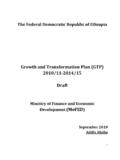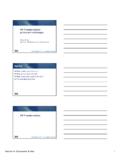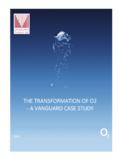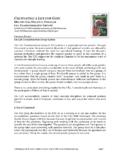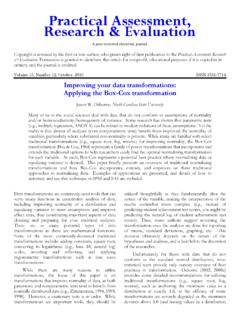Transcription of Organizational Assessment Models for Enterprise …
1 Organizational Assessment Models for Enterprise transformation L. Nathan Perkins Lean Advancement Initiative Massachusetts Institute of Technology 77 Massachusetts Ave, Building 41-205 Cambridge, MA 02139 Ricardo Valerdi Lean Advancement Initiative Massachusetts Institute of Technology 77 Massachusetts Ave, Building 41-205 Cambridge, MA 02139 Deborah Nightingale Lean Advancement Initiative Massachusetts Institute of Technology 77 Massachusetts Ave, Building 41-205 Cambridge, MA 02139 Stan Rifkin US Air Force Office of Scientific Research 875 North Randolph St. Arlington, VA 22203-1768 Copyright 2010 by L. Nathan Perkins, Ricardo Valerdi, Deborah Nightingale and Stan Rifkin. Published and used by INCOSE with permission. The US government retains unlimited right to reproduce and distribute this article. Abstract. Organizational Assessment is becoming increasingly important, both as a cross-time and cross-industry measurement and as a guiding force in Enterprise transformation .
2 Assessments provide crucial information about strengths, areas for improvement and potential investment strategies for achieving performance benefits. As performance is being recognized as a complex and multifaceted construct, Assessment tools seek to incorporate and reflect a holistic measurement of performance across multiple dimensions such as stakeholder value, leadership, culture and quality. With a growing range of tools available, this paper examines four prevalent Assessment strategies as examples of different approaches to Organizational Assessment . We compare these tools in terms of use cases, principles measured, outputs and contextual factors. Due to a lack of causal evidence between the principles assessed and objective evidence of improved Organizational performance, organizations should utilize the Assessment tool that best aligns with key transformation values or goals.
3 By committing to a relevant and useful Assessment tool and fully integrating it into strategic processes, organizations are able to achieve the internal knowledge and historical data necessary to improve performance and drive ongoing transformation efforts. Introduction Assessment has long been an integral tool in business transformation . By performing Assessment , businesses can understand their current state and use the results to help chart out a transformational path. During the transformation process, Assessment provides feedback and a measurement of progress in achieving the desired transformation . Assessment has often been done at several levels of business ranging from specific programs, projects or teams to international enterprises. Increased globalized competition and rapid innovation have generated a new focus on Enterprise -wide transformation (Rouse 2005), accompanied by a broader, multidimensional measurement of Enterprise performance.
4 Rather than simply using bottom-line costs and financial measures (Bourne, Franco et al. 2003), enterprises are now approaching transformation with an eye on culture, quality, stakeholder value, leadership commitment, process flow and Organizational learning (among others) (Maskell 1991). As mounting evidence backs this growing array of factors, Enterprise Assessment becomes both more important and more complex. These intangibles that benefit Organizational performance are harder to measure, because they are not readily apparent in existing data collection strategies ( , culture is often not reflected in traditional Organizational metrics). These new organization-wide assessments are not a replacement for departmental or process evaluation, Assessment and transformation , but rather a complement. By examining the broad structural elements and performance indicators of an organization, new insights are gained that aid in aligning Organizational actions with sustainable long-term goals (beyond the ongoing, short-term financial goals) (van De Ven 1976).
5 This paper seeks to introduce a handful of organization-wide Assessment tools and describe some of the important criteria that can be used to differentiate such tools. We begin by reviewing the role of Assessment at an Organizational level, and then examine four prevalent Models used today. With these four Models , we examine the different Assessment modes, stakeholders, input principles and outputs that tie into the transformation process. Why Assess Organizations? Assessments have longed been used for business and operations management. Assessing can act as a leading indicator for shifting performance (for example, are we retaining our strong performance in these areas? ) and for identifying program strengths and/or weaknesses (Hallam 2003). In addition to these internal roles for Assessment , it is equally important outside the organization.
6 Assessing can be used to create cross industry comparisons or assist in benchmarking against competitors and standards (such as Baldrige). These results can serve to motivate the organization, boost morale, help complete sales (by sharing Assessment results with customers) and even receive recognition or awards. When an Enterprise Assessment is shared with suppliers, it can be used to align and motivate all companies and players throughout a supply chain to drive a smooth production process and boost output. In addition, assessments are becoming an increasingly important tool in process and departmental improvement, and new tools offer organization-wide assessments that provide a holistic vantage for identifying the complex interactions across a broad Enterprise .
7 In order to design, execute and measure an Enterprise transformation strategy, having assessments that evaluate multiple dimensions of performance is crucial, both in terms of understanding the current state and charting out the transformation plan. Increasingly, enterprises are trying to leverage the multifaceted nature of performance in order to gain a competitive edge and maximize value delivery (Kueng 2003; Burton and Obel 2004). Early stage Assessment helps to identify performance gaps and prioritize points of focus, and plays a role in helping to generate a future-state vision for the organization as well as investment precedence. By showing problems with process flow or bottlenecks in Organizational performance, assessments provide a key tool in identifying opportunities for improvement. As the transformation plan is implemented, ongoing Assessment can then offer feedback and a measurement of progress and return on investment.
8 With this feedback, the transformation plan can be reviewed and revised over time. During Enterprise transformation , having a strong and useful Assessment tool is crucial in identifying where an organization is, where it wants to go, its rate of progress, and how best to approach that future state (Nightingale and Mize 2002). And with so much evidence to suggest that simply measuring something leads to improvement (Hauser and Katz 1998), Organizational Assessment ties in to the incentives and motivation for the overarching transformation plan. Challenges to Assessment The benefits to Organizational Assessment are many, but there are challenges to the Assessment process as well. When looking at program or process Assessment , it is easier to find assessments that work across companies and industries. But at the scale of Organizational Assessment , there is greater variability, both in structure and in values (what should be measured).
9 As a result of this variability, it is significantly more difficult to create a one-size-fits-all tool for Assessment . The needs and values of a manufacturing business are quite different than those of a service-oriented business. As a result, Organizational assessments have to make a tradeoff between industry or sector granularity and broad applicability. Even then, organizations will bypass Assessment , feeling that their unique situation cannot be reflected by a general Assessment , but this is often a misconception. Organizations may have unique challenges, but this does not stop an Assessment from being useful; instead, the transformation plan and goals must be internally derived to reflect the unique nature of the business. Other challenges result from conflicts between leadership and Assessment tools. Organizational Assessment may highlight different foci than the leadership intends, or may be tailored or executed in a way that simply reflects the leadership s desired outcome.
10 Hence an important challenge to good Assessment is commitment at multiple levels of the organization, both to the Assessment tool and its role in the broader transformation process. For the value of an Assessment tool to be maximized, an organization must commit to using a tool over a period of time (switching tools in the middle of a transformation plan undermines the role that Assessment plays in the whole transformation plan), so it is often beneficial to begin Assessment on a pilot basis with selected projects before making a larger commitment. Only as familiarity and understanding of an Assessment tool grow (as well as historic data), will the organization come to fully trust and therefore benefit from assessing. Just as with transformation , assessments must be used to complement leadership (rather than undermine or blindly support leadership values), and require commitment to accurate and on-going usage from those implementing the tool.

